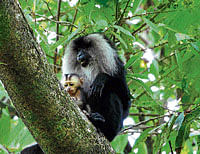
Declared as a reserve under Section 36 (A) of Wildlife Protection Act 1972, this reserve also aims to conserve rare and endangered swamp species of plants and several sacred groves.
The macaques were discovered by well known primatologist Dr Honnavalli N Kumara in 2002. Later on in 2007, a study taken up by Kumara and another researcher Santhosh K revealed that the world’s largest population of macaques dwell here.
“As per our estimation about 650 individuals dwell in 32 groups (the primate is a group dweller), which is the largest population in the world in the wild, in this contiguous forest bordering Sharavathi river,” Kumara told Deccan Herald.
Flagship species
A recently discovered frog species (Phylatus neelantrunsus) is also protected through the notification in the region. But the LTM has been the flagship species here as the notification too clearly mentions that it intends to protect the endangered species.
Santhosh says that these regions have unit houses (single houses) besides road connectivity provided to them along with electricity connections which posed a threat to these creatures.
The reserve which is spreads across Sirsi, Siddapaura, Honnavara and Kumta taluks of Uttara Kannada begins from the tri-junction point of Honnavara, Sirsi and Sagar division on the left bank of Sharavathi at a place called Ambepal gudda. On the eastern side is the Honnavara- Sirsi boundary , while on the west is Kangal Ghat gudda which touches Sharavathi river and joins Bangalore- Honnavara road. The notification dated June 13, 2011 says that the conservation reserve does not include any revenue land (villages), patta land, hakkals and betta lands.